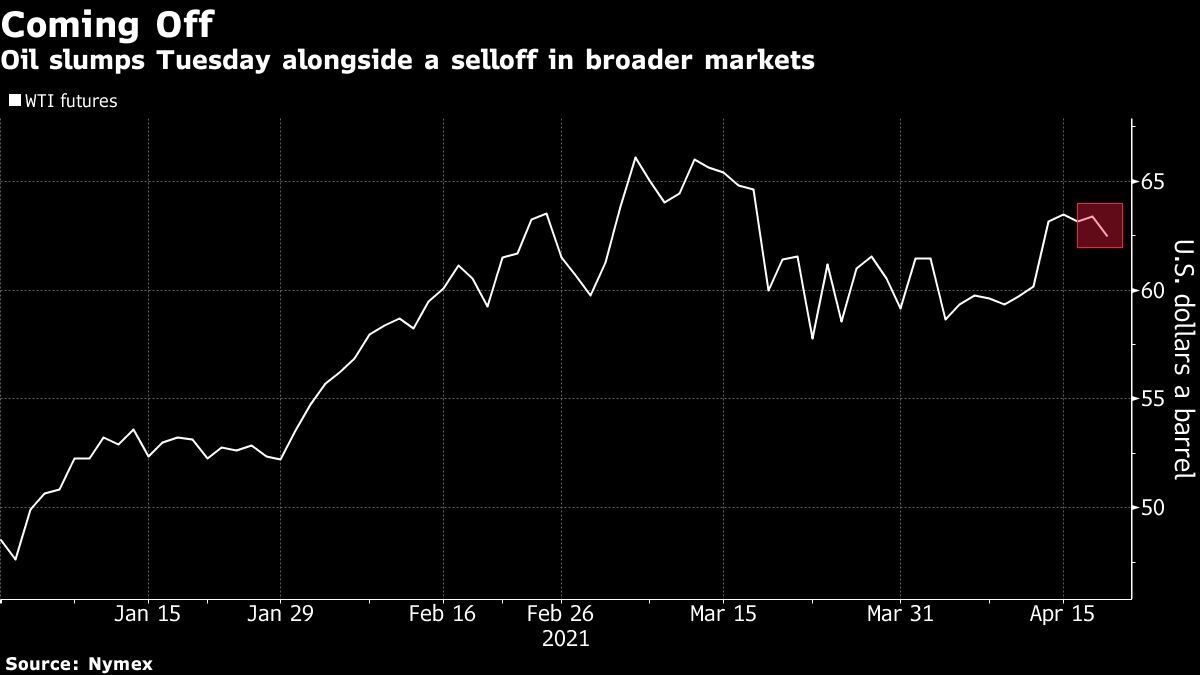Apr 19, 2021
Oil slides with broader market selloff adding to demand concerns
, Bloomberg News

Oil slumped the most in two weeks alongside a broader market rout as a resurgent virus in some of the world’s top oil importers highlighted the uneven road to recovery.
West Texas Intermediate fell 1.5 per cent to the lowest in a week as S&P 500 Index headed for its first back-to-back decline since late March. The rampant virus spread in countries such as India is casting a shadow on optimism over the global economic rebound. Annual crude imports in the Asian country fell for the first fiscal year since the late 1990s with refiners cutting run-rates.
“We’ve seen risk appetite reverse,” said Bart Melek, head of commodity strategy at TD Securities. “Variants are wreaking havoc on some economies, and it’s uncertain how the whole demand picture will evolve.”
The Bloomberg Dollar Spot Index was set to snap a six-day streak of declines, reducing the appeal of commodities priced in the currency.

Still, the market is a far cry from where it was a year ago today, when an unprecedented crisis saw U.S. benchmark crude futures closing at negative US$37.63 a barrel. The historic plunge came as lockdowns savaged demand and key producers Saudi Arabia and Russia flooded the market in a price war. A restoration of OPEC+ unity marked by deep supply cuts, as well as vaccine distribution around the world, have helped prices to climb back.
Despite near-term headwinds, there are also points of optimism for an upcoming surge in global oil consumption. Driving is soaring in the U.K. as more than 60 per cent of its population over 18 has received a first vaccine dose. Vitol Group, the world’s biggest independent oil trader, expects demand to come roaring back, echoing optimistic views from OPEC and the International Energy Agency.
“Once we get into May, we should start to see the next leg down in the virus, and that will be a tailwind for oil,” said Jay Hatfield, CEO at InfraCap in New York. “Until we get there, prices are likely to be range-bound.”
In options markets, growing confidence is being reflected in the so-called put skew. The premium that traders are willing to pay on bearish put options versus call options for global benchmark Brent futures narrowed to the smallest in a month on Tuesday.
Prices
- WTI for May delivery, which expired Tuesday, fell 94 cents to settle at US$62.44 a barrel
- The more active June contract slid 76 cents to US$62.67
- Brent for June fell 48 cents to US$66.57 a barrel
Along with concerns around the lagging demand recovery in some regions, signs of progress being made in talks on the revival of a 2015 nuclear deal raises the prospect of additional Iranian supply further out. A return to the deal could include lifting U.S. sanctions on the Persian Gulf country’s oil exports.
Meanwhile, U.S. oil stockpiles are expected to have fallen last week, which would extend the streak of drawdowns to four weeks, according to a Bloomberg survey. The American Petroleum Institute will report its figures later Tuesday ahead of U.S. government data.
In physical markets, front-month WTI’s widening discount to Brent is luring foreign demand for U.S. sour crudes. Southern Green Canyon is trading at the smallest discount to Nymex crude futures in two months, while other sours like Mars Blend and Poseidon have also strengthened recently. WTI is trading at a nearly $4-a-barrel premium to Brent compared to US$3 at the end of March.
Related news
- The price of crude grades that typically yield more fuels such as diesel are starting to weaken in Asia ahead of an increase in OPEC+ supply and amid faltering Indian demand due to a deadly coronavirus wave.
- Russia’s energy and finance ministries have reached an agreement on changes to the fuel-tax formula scheduled to be enforced from May 1, with the aim of easing pressure on local retail transport fuel rates amid a rise in global oil prices.
- For John Arnold, the legendary Houston trader who made his fortune betting against natural gas prices, the fossil-fuel industry seems finally ready to move on.
- Royal Dutch Shell Plc has named Geoffrey Mansfield to run its gasoline desk, following a reshuffle in the energy giant’s trading leadership, according to people with knowledge of the matter.
--With assistance from Sheela Tobben.



